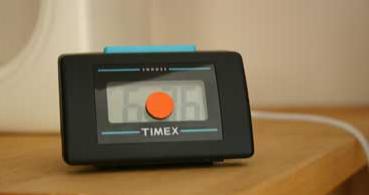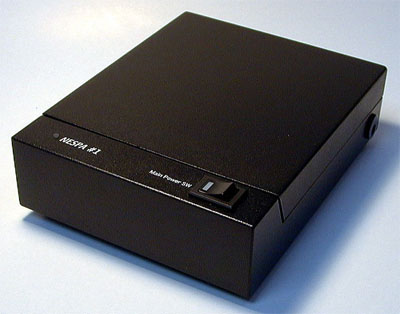|
You are reading the older HTML site
Positive Feedback
ISSUE
23
Tweaks from the other side - A tag-team approach to
the Clever Little Clock and
the Nanotec Nespa #1
The first car I ever owned was a Mazda GLC. The GLC stood for "great little car" and it was definitely an example of truth in advertising. I loved that car and it was great. Machina Dynamica offers a product called the Clever Little Clock, and like the GLC this is an example of truth in advertising. This clock is not just clever; it's very clever. The Clever Little Clock is based on concepts and products originally developed by PWB Electronics and Machina Dynamica produces the clock with permission from PWB. It is a small; battery powered clock that has been extensively modified. It does not plug into the wall, and has no direct influence on the audio signal, or the house wiring, or any of the audio gear or accessories. As with other products based on Peter Belt theories, this clock does not so affect the sound, but—and in my experience—how the listener responds to the sound. Instructions provided with the Clock are very clear. Once you take it out of its package and put it in your listening room you should notice a difference. After that, if you want to do an A/B comparison, the Clock needs to be placed outside the structure of your house. This means you can not simply sweep it into a drawer, or banish it to your garage, but the front porch is okay. We unpacked the Clock and put it into our listening room and decided to give it some time to break in. I rarely have time to listen to anything critically, so I couldn't make any judgments on whether there was a change in the way the music sounded. I knew I felt more at peace with the world, but otherwise I forgot about the Clock. When the time finally came to give it a critical listen, I decided to enlist Dave's help. He agreed to be the one to move the Clock in and out of the house.
I sat down to listen with stack of CDs that I had been meaning to listen to, as well as several I'd heard countless times before. I started with one of the latter and used the time to do some fact finding for another project. In other words, I decided to put the music on in the background while I engaged in searching out song lyrics for a graphics project I was working on. That way, the music would be on in the background, and I would pick up the changes subliminally. Well, in a word, everything sounded bad. I had to give up on my project, and just listen. I was surprised at how awful things sounded. In fact I wondered to myself if it was because I am still not used to our new CD player, or if it was the Clock having such an adverse affect on the sound. Undaunted, I continued to listen to both new and old music. I started with one of my old standbys, Bedroom Communities 01. Pillow Talk track 10 through track 14. These tracks are usually warm, and very engaging. "Demi To La" (Out of Phase) has an interesting beat that usually engenders foot tapping, but not this time. In fact, by the time I got to track 14 "Mas Fuerte Que El Sol" (The Vogado Projects) I turned it off completely, and that is my favorite track on the disc. The next disc I tried was one of those finds. It is a band I've admired for a long time in the confines of my car. Most of my serious listening gets done in the car these days since most of my music is of the "not well recorded" variety. Shrink by the Notwist is an exception in that it is music that I like, and it is relatively well recorded. When I played "Moron" I was disappointed, and "N.L." was not much better. I decided to make the trek down the hall to collect my only two SACDs, and I made an interesting discovery. The CD sounded better when I was outside the listening room. Back in the listening room I popped in my favorite SACD, The Other Side by Godsmack. I literally cringed when Sully Erna began to croon, and I really love his voice. In my car his voice brings tears to my eyes it's so beautiful. In the listening room I was diving for the remote to turn it off. I tried my other SACD The Downward Spiral by Nine Inch Nails, and while it was better sounding than Godsmack, it still didn't sound the way I remembered. Before I gave up completely, I decided to give some of my new discs a chance. I suspected that neither one of them was well recorded, but I was willing to give them a spin. First I tried My Kung Fu is Good by The Duke. I've become really enthralled with the track "Breathe" which is a haunting song featuring only Rich Ward's voice and piano. It regularly gives me shivers in my car. This track was the best track I'd heard all day, perhaps because of its simplicity. It sounded weaker than I was used to in my car, but it was a lot better than any of the other more complex pieces I'd listened to.
Finally, I popped in my Fozzy CD. Ah yes, the joys of mixing one passion with another, wrestling and reviewing audio gear. Fozzy is Chris Jericho's band, and the title track on All That Remains is one of my all-time favorite ever tracks. Sadly, this song sounded the worst of all. Tinny and bright, and did not produce the chills down my spine that it usually does. I was disappointed, and at this point seriously considering throwing the Clock out the window. Dave stepped in to make the switch, and I sat down to play on my computer and wait the proscribed twenty minutes. It actually ended up being more like forty five minutes as I got carried away chatting to friends online about how Rich Ward smoked Chris Jericho in my Fozzy Vs The Duke shootout. Thinking that the evil Clock had been removed from the room, I again fired up The Bedroom Communities and there was a clear and immediate difference. I felt completely a part of the music; the sensation was like floating in a sea of sound. Gone was the dissonance I had heard the first time. It sounded not just good, it sounded better than I'd ever heard it sound before. In fact, everything sounded better. Shrink sounded as good as I remembered it always had. In glee, I put on my SACDs again. Sadly, The Other Side is just not a well-recorded disc, either in Redbook or SACD, but at least this time I didn't cringe when I played it.
I found Dave busily tinkering with the site, and he asked me how it had gone. I gushed about the second listening session, and how everything had sounded so much better. I told him how I'd felt engulfed by the music, and so much a part of it, so connected to the music. Then I said point blank, "The Clock is in the room right now, isn't it." It wasn't a question, it was a statement. And you know what? I was right. The reason things had been less than enjoyable in the first session was because the Clock had been sitting out behind the garage next to the woodpile. The reason why everything sounded so good in the second session was because it had been hiding in the listening room, out of sight out of mind. In the final analysis, I want The Clever Little Clock. Machina Dynamica promises that with the Clock there will be less distortion, and that was genuinely the case. My curse is that usually my favorite music is so poorly recorded that it does sound distorted on our system. The Clock can not make up for a bad recording, but the distortion was lessened to such a degree that the bad recordings actually sounded good. I found my entire listening experience to be much more enjoyable with the Clock in place. My primary goal when listening to music is to be transported away from the cares of everyday life, and into a place where I fully connect with the music. That goal was attained beautifully with the Clever Little Clock. Machina Dynamica sells the clock direct for $199, and it's well worth the price. Machina Dynamica www.machinadynamica.com I would like to add that I made a point of turning on the system a good hour or more so that it was fully warmed-up. It was at this time that I decided to make the big switcheroo where Carol would listen with the idea that the clock was in the room (when it actually wasn’t) and then listen thinking the clock was out of the room (when it was actually in). I did this to eliminate to a great degree any potential for her to hear what she thought she should be hearing, thereby seeing if the clock really did have any effect on her—good or bad. As it turned out, her reaction was right on. She did not enjoy the music when she thought she should be and really enjoyed the music when she thought she should not. Does it really work? Well it did for her, and to be quite honest, in listening from the other room—even though I knew what was going on—I too found myself having the same reaction as she was to the music she was playing. - Dave
The Nespa #1 ($595 US) by Nanotec Systems out of Japan, is labeled an Optical Disc Finalizer—meaning that it finalizes whatever was not finalized when a CD was produced. What was not finalized you ask… Well, let’s consider how a CD is manufactured (courtesy of Dub-it.com and 6moons.com):
Nanotec Systems theorizes that the aluminum film has random irregularities in its adhesion to the surface of a disc. These irregularities are microscopic gaps existing between the film and polycarbonate substrate. The gaps are filled with the residue of the lubricant used in the stamping process. The intent of the NESPA is to eliminate or mitigate these gaps by applying a high intensity light to a spinning CD for a defined period of time, causing the residue to heat up to a point where it vaporizes and vacates the gap leaving it flatter and more even—an easier read for the laser. That is, these random oil-filled gaps are seen to be an obstacle to the laser in reading the 1s and 0s correctly, thereby causing some confusion as to whether it is a 1 or a 0—resulting in greater error correction and potentially greater error in the errors as they are corrected. Nespa’s idea is that the more correction needed will lead to poorer sound—meaning less music, less whatever. We could also say it could lead to maybe hearing more whatever. Like hearing more digital crap and edgy nastiness. Nespa refers to this as spurious noise with the result being more accuracy and clarity.. Uh …gee, I will leave the validity of this up to those that know way more about error correction and 1s and 0s then me …but I can say that CDs spun on the Nespa do sound different. How different? More musically different. I hear more stuff—greater resolution, more information. Perhaps due to the Nespa theory, I am hearing more of the right right and less wrong right information. Even so, discs have less of that "digital presence", sounding more at ease and "natural". Natural in the sense of what things should sound like—voices sounding more like real voices, guitars more like real guitars, stuff sounding more like real stuff, etc. You will hear more air, more space, more there thereness. Dramatic? Not in the sense that you will crap in your pants, but everyone who has been here has heard the same sort of things that I mentioned above, though to varying degrees. And, everyone liked what it did. On some discs some across as sounding not so much thinner (though it could be construed that way), but less rich and full (which should not be construed as poor and empty—poor of soul and empty of life). Sort of like having been on a good diet, these recordings have lost a bit of the ponderousness or bloat that made them, a times, a bit too much. After Nespa-neering, they sound (especially through the voices and the bass range) lighter and quicker—more air and speed, less denseness and creep. The music has way better flow and articulation—it is simply more musical and involving. Use of the Nespa is pretty straight-forward. Lift the lid, remove the magnetic puck, drop in a disc label side up, place the puck to hold the disc in-place, lower the lid, switch the unit on, and wait till it shuts off—about 2 minutes or 110-150 flashes. It has been mentioned elsewhere, that if one uses the Nespa too much one can over cook their discs rendering them un-playable. Well, the US Distributor suggests that once a disc has been spun, taking another spin at a later time may actually take the disc a bit further. Nanotec suggests that even as many as 10 times is safe, regardless if they occur over a period of time or all at once. But, the instruction says that too much treatment could lead to the hardening or cracking of the disc, with a maximum treatment time of 4 minutes. Which is which, I have no clue, nor I have not tried this, but it is nice to know if one forgets to mark a spun discs and ends up taking one for another spin all should be fine. Highly Recommended. Nanotec www.nanotec-systems.jp Sounds of Silence www.soundsofsilence.com
|




 As I played The Duke again, and fell in love with
"Breathe" all over again, a thought began to form in the back of my head. "Wait
a minute," I thought as Rich Ward warbled his love song, "I thought this
blissful listening experience I'm having right now is what the Clock is supposed
to do." As I took The Duke out and put Fozzy back in I thought, "I wonder if the
Clock is in here now, because I am definitely enjoying this listening session
far more than I did the first one." I smiled because even "All That Remains"
sounded good. That's when it hit me, the Clock had been out of the room during
the first session, and it was in the room now, precisely the opposite of what
Dave had lead me to believe.
As I played The Duke again, and fell in love with
"Breathe" all over again, a thought began to form in the back of my head. "Wait
a minute," I thought as Rich Ward warbled his love song, "I thought this
blissful listening experience I'm having right now is what the Clock is supposed
to do." As I took The Duke out and put Fozzy back in I thought, "I wonder if the
Clock is in here now, because I am definitely enjoying this listening session
far more than I did the first one." I smiled because even "All That Remains"
sounded good. That's when it hit me, the Clock had been out of the room during
the first session, and it was in the room now, precisely the opposite of what
Dave had lead me to believe.